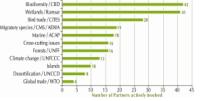
BirdLife Partners are working to build constituencies at many different levels: through their own membership, through diverse networks of Local Conservation Groups, through strategic partnerships with industry and through constructive engagement with governments. As part of their work with governments, more and more Partners are tackling policy issues, with over 70 active in 2007 compared to just six in 1998. As well as policy sectors that deal directly with biodiversity, Partners are also starting to address those that have a major indirect impact (such as climate change), or cut across the other sectors (such as poverty reduction, conservation finance and tourism).

BirdLife International Partners (national non-governmental organisations) are increasingly engaging with policy to address threats causing declines in biodiversity. A survey conducted in 2007 showed that the capacity of BirdLife International to address policy and advocacy has continued to grow from ten staff in six Partners in 1998, to 42 staff in 27 Partners in 2001, and more than 70 Partners in six regions by 2007 (representing 66% of those surveyed).
The policy sectors tackled include those dealing with biodiversity, forests, drylands and desertification, wetlands, the marine environment, islands, wildlife trade, global trade, migratory species and climate change (see figure). Activities range from lobbying governments to giving legal protection to important sites for bird conservation (IBAs) at the national level, to participating at meetings of Multilateral Environmental Agreements at the international level (Mwangi 2007). The diversity of policy issues engaged with is reflected in the cross-cutting sectors including HIV/AIDS, poverty, land-use planning, Environmental Impact Assessment, “greening” of budgets, Overseas Development Assistance, tourism, hunting, watersheds, aquaculture, livelihoods, and invasive species.
References
Compiled: 2008
Recommended Citation:
BirdLife International (2008)
Bird conservation organisations are increasingly engaging with policy work.
Downloaded from https://datazone.birdlife.org/sowb/casestudy/bird-conservation-organisations-are-increasingly-engaging-with-policy-work on 22/12/2024